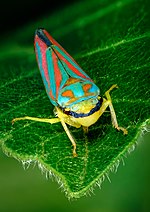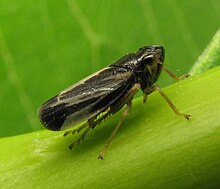Шефоппер
| Лифхопперс Временный диапазон:
| |
|---|---|

| |
| Взрослые две облицованные деревянные деревья ( Eurymeloides Bicincta , Eurymelinae ) с симбиотическими мясо | |
| Научная классификация | |
| Домен: | Эукариота |
| Королевство: | Животное |
| Филум: | Членистоногие |
| Сорт: | Инсекта |
| Order: | Hemiptera |
| Suborder: | Auchenorrhyncha |
| Superfamily: | Membracoidea |
| Family: | Cicadellidae Latreille, 1802 |
| Subfamilies | |
|
24, see text | |

Leafhopper является общим названием для любого вида из семейства Cicadellidae . Эти мелкие насекомые , в разговорной разговорной речи, известные как бункеры , представляют собой кормушки для растений, которые сосут растительный сок из травы, кустарников или деревьев. Их задние ноги модифицированы для прыжков и покрыты волосками, которые облегчают распространение секреции по их телам, которое действует как репеллент воды и носитель феромонов . [ 1 ] Они подвергаются частичной метаморфозе и имеют различные ассоциации хозяев, варьируя от очень обобщенных до очень специфических. Некоторые виды имеют космополитическое распределение или происходят в умеренных и тропических областях. Некоторые из них являются вредителями или векторами вирусов растений и фитоплазмы . [ 1 ] Семейство распределяется по всему миру и составляет второе по величине семейство гемиптеранов, причем не менее 20 000 описанных видов.
Они принадлежат к происхождению, традиционно рассматриваемой как в подтронстве цикадоморфа в подходе Auchenorrhyncha . Иногда это было помещено в его собственную подготовку (Clypeorrhyncha), [ 2 ] Но более поздние исследования сохраняют его в Auchenorrhyncha. [ 3 ]
Members of the tribe Proconiini of the subfamily Cicadellinae are commonly known as sharpshooters.[4]
Description and ecology
[edit]
The Cicadellidae combine the following features:
- The thickened part of the antennae is very short and ends with a bristle (arista).
- Two ocelli (simple eyes) are present on the top or front of the head.
- The tarsi are made of three segments.
- The femora are at front with, at most, weak spines.
- The hind tibiae have one or more distinct keels, with a row of movable spines on each, sometimes on enlarged bases.
- The base of the middle legs is close together where they originate under the thorax.
- The front wings not particularly thickened.
An additional and unique character of leafhoppers is the production of brochosomes, which are thought to protect the animals, and particularly their egg clutches, from predation as well as pathogens.

Like other Exopterygota, the leafhoppers undergo direct development from nymph to adult without a pupal stage. While many leafhoppers are drab little insects as is typical for the Membracoidea, the adults and nymphs of some species are quite colorful. Some – in particular Stegelytrinae – have largely translucent wings and resemble flies at a casual glance.
Leafhoppers have piercing-sucking mouthparts, enabling them to feed on plant sap. A leafhoppers' diet commonly consists of sap from a wide and diverse range of plants, but some are more host-specific. Leafhoppers mainly are herbivores, but some are known to eat smaller insects, such as aphids, on occasion. A few species are known to be mud-puddling, but as it seems, females rarely engage in such behavior. Many species are also known to opportunistically pierce the human skin and draw blood but the function of such behaviour is unclear.[5]
Leafhoppers are micropredators that can act as vectors transmitting plant pathogens, such as viruses, phytoplasmas and bacteria.[6][7] Cicadellidae species that are significant agricultural pests include the beet leafhopper (Circulifer tenellus), the maize leafhopper (Cicadulina mbila), potato leafhopper (Empoasca fabae), two-spotted leafhopper (Sophonia rufofascia), blue-green sharpshooter (Graphocephala atropunctata), glassy-winged sharpshooter (Homalodisca vitripennis), the common brown leafhopper (Orosius orientalis), rice green leafhoppers (Nephotettix spp.), and the white apple leafhopper (Typhlocyba pomaria). The beet leafhopper (Circulifer tenellus) can transmit the beet curly top virus to various members of the nightshade family, including tobacco, tomato, or eggplant, and is a serious vector of the disease in chili pepper in the Southwestern United States.
In some cases, the plant pathogens distributed by leafhoppers are also pathogens of the insects themselves, and can replicate within the leafhoppers' salivary glands. Leafhoppers are also susceptible to various insect pathogens, including Dicistroviridae viruses, bacteria and fungi; numerous parasitoids attack the eggs and the adults provide food for small insectivores.
Some species such as the Australian Kahaono montana even build silk nests under the leaves of trees they live in, to protect them from predators.[8]
Systematics
[edit]In the now-obsolete classification that was used throughout much of the 20th century, the leafhoppers were part of the Homoptera, a paraphyletic assemblage uniting the basal lineages of Hemiptera and ranked as suborder. The splitting of the Homoptera is likely to be repeated for the Auchenorrhyncha for similar reasons, as the Auchenorrhyncha simply seem to group the moderately advanced Hemiptera, regardless of the fact the highly apomorphic Coleorrhyncha and Heteroptera (typical bugs) evolved from auchenorrhynchans. Hence, a recent trend treats the most advanced hemipterans as three or four lineages, namely Archaeorrhyncha (Fulgoromorpha if included in Auchenorrhyncha), Coleorrhyncha and Heteroptera (sometimes united as Prosorrhyncha) and Clypeorrhyncha.[9][10][11]

Within the latter, the three traditional superfamilies – Cercopoidea (froghoppers and spittlebugs), Cicadoidea (cicadas) and Membracoidea – appear to be monophyletic. The leafhoppers are the most basal living lineage of Membracoidea, which otherwise include the families Aetalionidae (aetalionid treehoppers), Membracidae (typical treehoppers and thorn bugs), Melizoderidae, and Myerslopiidae.[9][10][11]
Subfamilies
[edit]





The leafhoppers are divided into 25 subfamilies,[12] which are listed here alphabetically, as too little is known about the family's internal phylogeny.
- Aphrodinae
- Bathysmatophorinae
- Cicadellinae
- Coelidiinae
- Deltocephalinae
- Errhomeninae
- Euacanthellinae
- Eurymelinae
- Evacanthinae
- Hylicinae
- Iassinae
- Jascopinae
- Ledrinae
- Megophthalminae
- Mileewinae
- Nastlopiinae
- Neobalinae
- Neocoelidiinae
- Nioniinae
- Phereurhininae
- Portaninae
- Signoretiinae
- Tartessinae
- Typhlocybinae
- Ulopinae
- Further information: Agalliopsis, Utecha trivia
See also
[edit]References
[edit]- ^ Подпрыгнуть до: а беременный Стиллер, Майкл (октябрь - декабрь 2009 г.). «Биосистематика: листья, связанные с лугами Южной Африки - эндемики по биомам на пастбище» (PDF) . Новости защиты растений . 82 : 6. [ Постоянная мертвая ссылка ]
- ^ Соренсен, Джон Т.; Кэмпбелл, Брюс С.; Джилл, Рэймонд Дж. (1995). «Немонофилия auchenorrhyncha (« Гомоптера »), основанная на филогении 18S рДНК: эковолюционные и кладистические последствия в рамках до гетероптеродеи гемиптеры (SL) и предложение о новых монофилетических подчиненных» . Пана-Тихоокеанский энтомолог . 71 (1): 31–60.
- ^ Крайан, Джейсон Р.; Урбан, Джули М. (2012). «Филогения более высокого уровня гемиптера гемиптера насекомых: действительно ли парафилетическая?» Полем Систематическая энтомология . 37 (1): 7–21. Bibcode : 2012sysen..37 .... 7c . doi : 10.1111/j.1365-3113.2011.00611.x . S2CID 86564882 .
- ^ Paradell, Susana L.; Virla, Eduardo G.; Logarzo, Guillermo A.; Dellapé, Gimena (2012). «Проконини -снайы из Аргентины, с заметками о его распространении, растениях -хозяевах и естественных врагах» . Журнал науки насекомых . 12 (116): 116. doi : 10.1673/031.012.11601 . ISSN 1536-2442 . PMC 3633250 . PMID 23445207 .
- ^ Нуньес, Эдвин Домингес; Aiello, Annette (2013-01-01). «Leafhoppers (Homoptera: Cicadellidae), которые исследуют человеческую кожу: обзор мировой литературы и девятнадцати новых записей, от Панамы». Земные обзоры членистоногих . 6 (3): 201–225. doi : 10.1163/18749836-06001064 . ISSN 1874-9836 . S2CID 36637453 .
- ^ Пулин, Роберт ; Рандхава, Хасиб С. (февраль 2015 г.). «Эволюция паразитизма вдоль конвергентных линий: от экологии до геномики» . Паразитология . 142 (Suppl 1): S6 - S15. doi : 10.1017/s0031182013001674 . PMC 4413784 . PMID 24229807 .

- ^ Weintraub, pg; Beanland, L (2006). «Переносные векторы насекомых фитоплазмы». Ежегодный обзор энтомологии . 51 : 91–111. doi : 10.1146/annurev.ento.51.110104.151039 . PMID 16332205 .
- ^ Гурр, Джефф М.; Флетчер, Мюррей Дж. (2011). «Производство шелка австралийским эндемичным листовым листьями Кахаоно Монтана Эванс (Cicadellidae: Typhlocybinae: Dikraneurini) обеспечивает защиту от хищников». Австралийский журнал энтомологии : нет. doi : 10.1111/j.1440-6055.2011.00813.x .
- ^ Подпрыгнуть до: а беременный Дэвид Р. Мэддисон (1 января 1995 г.). «Hemiptera. Истинные ошибки, цикады, листовины, тля и т. Д.» . Веб -проект Tree of Life . Получено 24 августа 2010 года .
- ^ Подпрыгнуть до: а беременный «Аухенорринча» . Веб -проект Tree of Life . 1 января 1995 . Получено 24 августа 2010 года .
- ^ Подпрыгнуть до: а беременный "Membracoidea" . Веб -проект Tree of Life . 1 января 1995 . Получено 24 августа 2010 года .
- ^ "Cicadellidae" . 3i интерактивные ключи и таксономические базы данных . 28 апреля 2020 года.
Дальнейшее чтение
[ редактировать ]- Карвер, М, Ф.Г. Гросс и те. Вудворд. 1991. Hemiptera (Bugs, Leafhoppers, Cicadas, тлю, масштабные насекомые и т. Д.) В: Насекомые Австралии - учебник для студентов и исследовательских работников. Том 1. Издательство из издательства Мельбурнского университета, Мельбурн, Австралия ».
Внешние ссылки
[ редактировать ] Данные, связанные с Cicadellidae в Wikispecies
Данные, связанные с Cicadellidae в Wikispecies  СМИ, связанные с Cicadellidae в Wikimedia Commons
СМИ, связанные с Cicadellidae в Wikimedia Commons - Красная полосатая листья Graphocephala Coccinea -Диагностические фотографии и информация
- Обследование естественной истории Иллинойса: Archived Leafhoppers 2015-04-17 в The Wayback Machine
- Leafhoppers северной и Южной Америки
- Стрелкой листьев мира (Hemiptera: Cicadellinae) - онлайн -база данных с цветными фотографиями почти всех описанных видов.
- Leafhoppers County County Florida
- NMSU энтомология патология растений; Наука сорняков. «Университет штата Нью -Мексико Кэрол Сазерленд Коллекция Leafhopper» . Архивировано из оригинала 2013-05-01 . Получено 2013-07-15 .
- Auchenorrhyncha Keys, Австралия и соседние районы архив 2016-07-18 на The Wayback Machine
- DRMETCALF: Ресурс на цикадах, листьях, Planthoppers, Spittlebugs и Treehoppers